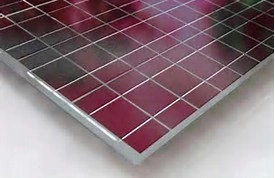What are solar cells?
Just like solar panels, solar cells also come in different quality levels. Standard solar panels use standard-quality solar cells, the vast majority of which are produced in China. Even when panels are assembled elsewhere, the individual components, such as the solar cells, often originate from China.
Higher-quality solar cells also exist, such as the ‘Maxeon’ cells by SunPower. These feature a thick, durable copper backing, making them more resistant to damage than conventional cells. Additionally, the electrical connections between the cells are more robust, reducing the risk of breakage. SunPower is so confident in the durability of these solar cells that they offer a 40-year product warranty on their solar panels.
The efficiency of solar cells determines how much of the sun’s energy is converted into electricity. In recent years, efficiency levels have significantly improved, reaching around 20-25%. This means that 20-25% of the sun’s radiation is transformed into usable power. While efficiency gains are still being made, they now typically increase by only fractions of a percent. Major breakthroughs may still come, but new high-efficiency solar cells generally take many years of research before they can be affordably and reliably integrated into commercial panels.
High-quality cells also differ from standard ones in terms of efficiency. While standard solar cells do not exceed 22% efficiency, Maxeon cells boast even higher efficiency levels, allowing SunPower panels to achieve over 25% efficiency—the highest available for commercial panels. SunPower continues to break records in this field.
The power output of a solar panel depends on the number of solar cells it contains. Most standard panels have 60 solar cells, arranged in 6 columns of 10 cells. Other configurations include 72-cell panels (6 × 12 layout) and 96-cell panels (8 × 12 layout), such as those from SunPower. The more solar cells a panel has, the higher its power output.
Because each solar cell generates a certain voltage, and all the cells are connected in series, the total voltage of a solar panel depends on the number of cells it contains. SunPower panels, with their higher cell count, also have a higher voltage than standard panels.
-
Quality differences
Just like solar panels, solar cells also come in different quality levels. Standard solar panels use standard-quality solar cells, the vast majority of which are produced in China. Even when panels are assembled elsewhere, the individual components, such as the solar cells, often originate from China.
Higher-quality solar cells also exist, such as the ‘Maxeon’ cells by SunPower. These feature a thick, durable copper backing, making them more resistant to damage than conventional cells. Additionally, the electrical connections between the cells are more robust, reducing the risk of breakage. SunPower is so confident in the durability of these solar cells that they offer a 40-year product warranty on their solar panels.
-
Efficiency
The efficiency of solar cells determines how much of the sun’s energy is converted into electricity. In recent years, efficiency levels have significantly improved, reaching around 20-25%. This means that 20-25% of the sun’s radiation is transformed into usable power. While efficiency gains are still being made, they now typically increase by only fractions of a percent. Major breakthroughs may still come, but new high-efficiency solar cells generally take many years of research before they can be affordably and reliably integrated into commercial panels.
High-quality cells also differ from standard ones in terms of efficiency. While standard solar cells do not exceed 22% efficiency, Maxeon cells boast even higher efficiency levels, allowing SunPower panels to achieve over 25% efficiency—the highest available for commercial panels. SunPower continues to break records in this field.
-
Power output
The power output of a solar panel depends on the number of solar cells it contains. Most standard panels have 60 solar cells, arranged in 6 columns of 10 cells. Other configurations include 72-cell panels (6 × 12 layout) and 96-cell panels (8 × 12 layout), such as those from SunPower. The more solar cells a panel has, the higher its power output.
Because each solar cell generates a certain voltage, and all the cells are connected in series, the total voltage of a solar panel depends on the number of cells it contains. SunPower panels, with their higher cell count, also have a higher voltage than standard panels.
What happens if a solar cell fails?
If a solar cell breaks, it can no longer conduct electricity, disrupting the current flow in the panel. To mitigate this, by pass diodes reroute the current, but this disables part of the panel.
A solar cell can break due to:
-
Physical impact (e.g., a falling rock)
-
Sustained overheating (hotspot formation)
Individual solar cells cannot be replaced—if a cell is damaged, the entire solar panel needs to be replaced for full restoration.
SunPower has an interesting YouTube video about solar cells.
Select a category
Find your question
Enter a keyword to search through our FAQ
Click here for an overview of all terms used, with a brief explanation of each term.
List of terms

